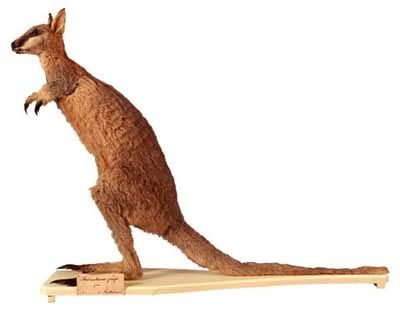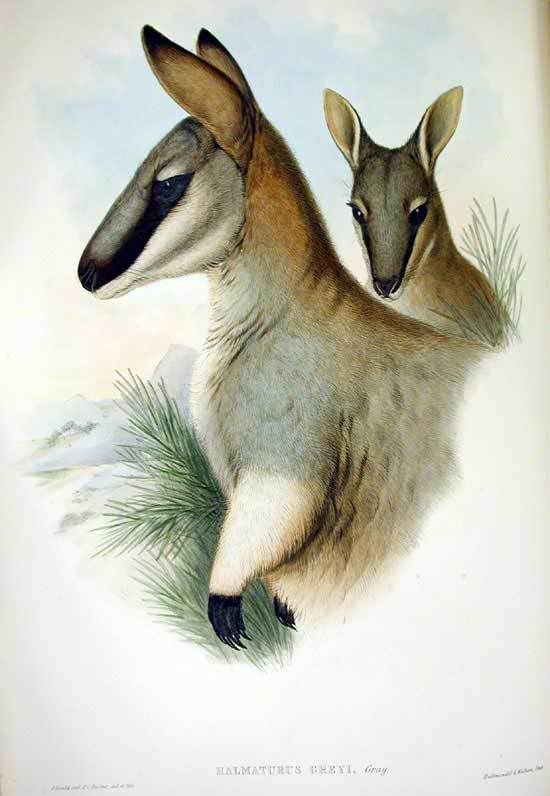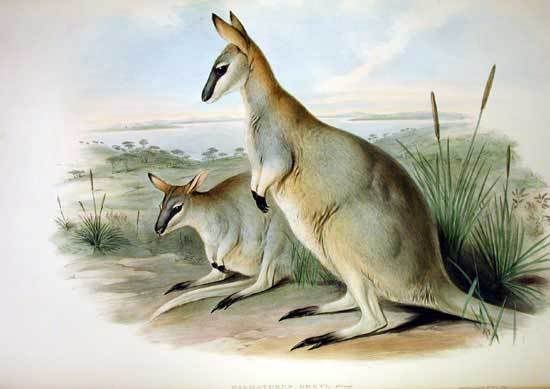|
|
Post by another specialist on Dec 5, 2006 10:52:14 GMT
TOOLACHE WALLABY Macropus greyi Macropus greyi was endemic to Australia. The last wild individuals were recorded in 1924, although a few captives survived until around 1937. Introduced predators, competition from livestock, bounty and sport hunting, and direct killing for the animal's pelt have resulted in the extinction of M. greyi. |
|
|
|
Post by another specialist on Dec 5, 2006 11:02:33 GMT
|
|
|
|
Post by another specialist on Dec 5, 2006 11:21:46 GMT
 Gap in nature |
|
|
|
Post by another specialist on Dec 5, 2006 11:23:40 GMT
May 8, 1997 Pg42, Country Life WA islands offer refuge for the Mala Though not found in South Australia anymore, the Mala can still be seen in the wild on two small islands off the coast off Western Australia. It was last seen in SA in 1933 around the Musgrave Ranges region. The Mala feeds at night, and during the day it rests in a short burrow - usually under a spinifex plant where it can be shielded from the hot sun. The Eastern Hare wallaby is sometimes known as the Brown Hare-wallaby but its scientific name is Largorchestes leporides. This kind of wallaby is now extinct in the wild but it was once found here in South Australia, especially around the River Murray and South-East of the state. The last report of one in SA was in 1892 at Lucindale. The Eastern Hare Wallaby has brown hair which is white on the ends, grey hair on its belly and its feet, and the front paws are also a greyish colour. It has a black patch on the elbow and the tail is brown on top and white underneath. It could reportedly jump up to 1.8 meters. The Toolache Wallaby lived in flat, swampy environments and was a fast animal that could keep moving at high speed for long periods of time. Its scientific name was the Macropus greyi, ,but some of the common names given to this animal include Monkeyface, Onetwo, and Grey’s Wallaby. The Toolache Wallaby is now extinct in the wild. It was a pale grey-fawn above, fawn below, and had an almost white tail. Wedgetail eagles and foxes sometimes preyed on the young Toolache Wallaby, but it was also hunted by humans for sport - and killed for its valuable and beautiful pelt. Its habitat was also good for grazing livestock, which meant a decline in the Toolache Wallaby population. The Toolache Wallaby was last reported in SA in the 1920’s. The Crescent Nailtail Wallaby, scientifically known as the Onychogalea lunata, was once found in the eucalypt and mulga forests of southern and central Australia. Sometimes known as the Lunated Nailtail Wallaby, Warrung or Tjawalpa, this animal was mainly ash-grey with a paly grey belly and a crescent-shaped white stripe across the shoulder and hip. It had a pointy nail-like tip at the end of its tail. It was last spotted in SA in the Musgrave Ranges in the 1930’s. The Crescent Nailtail Wallaby was a nocturnal animal and ate at night, sleeping under shrubs or low trees or lazing in the sun during the day. It was between 371 - 508 mm long with a tail 153 - 330 mm. www.samuseum.sa.gov.au/orig/extinctions/stockjnl.htm |
|
|
|
Post by another specialist on Dec 5, 2006 11:25:51 GMT
The toolache wallaby (Macropus greyi) is an extinct species of wallaby from South-western South Australia and South-western Victoria. Many people considered it to be the most elegant, graceful and swift species of kangaroo. It had fine fur with alternating bands of darker and lighter grey across the back. The bands differed in their colour and texture. The marking may have varied seasonally or between individuals. Its hopping consisted on two short hops, then a long one. The wallaby was gregarious, with groups being loyal to a particular location. Greyhounds were used to chase the wallabies, which never hurroed until the dogs got close and then bounded away. One individual was chased on horseback for six kilometres and escaped through a fence. The wallaby was hunted for fur and sport and was affected by pastoralism. It was relatively common until 1910, but was very rare in 1923, with the last known group of 14 inhabiting the Konetta sheep run near Robe on the South Australian coast. Professor Wood Jones and others failed in attempts to capture wallabies and transfer them to a sancturay on Kangaroo Island. Four individuals were captured, all dead or dying by being driven too hard; they died from exhaustion and shock. Local hunters harassed wallabies to obtain pelts or trophies. A female, with a young in her pouch, was captured and survived in captivity at Robe until 1939. One wallaby may have been captured in 1943. The wallaby became extinct due to hunting, foxes and land clearance. Source: 'A Gap in Nature' by Tim Flannery and Peter Schouten (2001), published by William Heinemann en.wikipedia.org/wiki/Toolache_wallaby |
|
|
|
Post by another specialist on Dec 5, 2006 11:29:49 GMT
Toolache Wallaby The price of a beautiful pelt The Toolache Wallaby, Macropus greyi Waterhouse, 1845 was confined to a relatively small area in South-eastern Australia. It lived in low-lying grasslands which became swampy in winter. The animals were recorded to be "far from uncommon even as late as 1910". The last member of this species may have been a captive female that survived till at least 1927. However, sightings have been reported as recently as 1972.  Toolache Wallaby. Favourite prey Hunting by man was probably the main cause of extinction, as the beautiful pelt was in great demand. Furthermore, this open-country wallaby was a very fast animal. Its combination of high speed and unpredictable jumps made it a favourite for dog-hunts. The Toolache Wallaby had been greatly reduced in numbers by 1923, at which time conservation measures were proposed. However, the attention given to the species had the opposite effect and resulted in hunters killing part of the remaining population. A second factor in the extermination of the Toolache Wallabymay have been the introduction of the fox, which preyed on the young wallabies. The museum collection The specimen in the National Museum of Natural History was purchased from the dealer G.A. Frankin the 19th century. Provenance and collection date are unknown. www.naturalis.nl/300pearls/ |
|
|
|
Post by another specialist on Sept 10, 2007 14:33:07 GMT
|
|
|
|
Post by another specialist on Sept 10, 2007 14:35:35 GMT
Australian Mammal Gould Print Images John Gould print image of the Toolache Wallaby Macropus greyi (formerly known as Halmaturus greyi)  Photo from "Mammals of Australia", Vol. II Plate 18 Part of the 3 Volumes by John Gould, F.R.S. Published by the author, 26 Charlotte Street, Bedford Square, London, 1863 Reproduction Photo by Marnie Rawlinson, Cathy Accurso and Ken Walker © Museum Victoria www.museum.vic.gov.au/bioinformatics/mammals/images/Hal_gre2.htm |
|
|
|
Post by another specialist on Sept 10, 2007 14:38:50 GMT
Australian Mammal Gould Print Images John Gould print image of the Toolache Wallaby Macropus greyi (formerly known as Halmaturus greyi)  Photo from "Mammals of Australia", Vol. II Plate 19 Part of the 3 Volumes by John Gould, F.R.S. Published by the author, 26 Charlotte Street, Bedford Square, London, 1863 Reproduction Photo by Marnie Rawlinson, Cathy Accurso and Ken Walker © Museum Victoria www.museum.vic.gov.au/ |
|
|
|
Post by another specialist on Sept 10, 2007 14:40:48 GMT
|
|
|
|
Post by another specialist on Sept 10, 2007 20:31:07 GMT
|
|
|
|
Post by another specialist on Jan 4, 2008 10:47:52 GMT
|
|
|
|
Post by another specialist on Jan 4, 2008 10:48:12 GMT
|
|
|
|
Post by another specialist on Jan 4, 2008 10:48:36 GMT
|
|
|
|
Post by another specialist on Jan 4, 2008 10:48:58 GMT
|
|
|
|
Post by another specialist on Jan 4, 2008 10:51:13 GMT
 All above from The Toolache Wallaby National Parks and Wildlife Service, Department of Environment and Planning, Special Publication, Number 2. A book I've had for years just found it. |
|
|
|
Post by another specialist on Jul 9, 2008 16:37:05 GMT
Macropus (Notamacropus) greyi Author: Waterhouse, 1846. Citation: Nat. Hist. Mamm., 1: 122. Common Name: Toolache Wallaby Type Locality: Australia, South Australia, Coorong. Distribution: Formerly SE South Australia and adjacent Victoria. Status: IUCN – Extinct. Comments: Subgenus Notamacropus. Almost certainly extinct (Kirsch and Calaby, 1977:22; Ride, 1970:47). www.bucknell.edu/msw3/browse.asp?id=11000259 |
|
|
|
Post by Peter on Jul 12, 2008 15:35:07 GMT
Amazing to see these images of live Toolache wallaby. Never knew they existed.
|
|
|
|
Post by another specialist on Jul 12, 2008 20:50:31 GMT
Amazing to see these images of live Toolache wallaby. Never knew they existed. There great ain't they. Main reason I bought that book all about the Macropus greyi got good load of images and alot of info to on sighting etc. |
|
|
|
Post by Melanie on Oct 6, 2008 15:31:32 GMT
Scientific Name: Macropus greyi Species Authority Intra-specific Authority: Waterhouse, 1845 Common Name/s: English – Toolache Wallaby Assessment Information [top] Red List Category & Criteria: Extinct ver 3.1 Year Assessed: 2008 Assessor/s Australasian Mammal Assessment Workshop Evaluator/s: Lamoreux, J. & Hilton-Taylor, C. (Global Mammal Assessment Team) Justification: Listed as Extinct because the last wild individuals of Macropus greyi were recorded in 1924, although a few captives survived until around 1937. This species has not be recorded since, despite extensive research in the region. History: 1996 - Extinct (Thornback and Jenkins 1982) 1982 - Extinct (Thornback and Jenkins 1982) 1986 - Extinct (Thornback and Jenkins 1982) 1988 - Extinct (Thornback and Jenkins 1982) 1990 - Extinct (Thornback and Jenkins 1982) 1994 - Extinct (Thornback and Jenkins 1982) Geographic Range [top] Range Description: This species was endemic to Australia, where it was generally restricted to south-eastern South Australia. The last wild individuals were recorded in 1924, although a few captives survived until around 1937. Surveys conducted by the South Australia National Parks and Wildlife Service suggest that the species persisted until the early 1970's (Smith and Robinson 2008). Countries: Regionally extinct: Australia Population [top] Population: It is presumed to be extinct. Habitat and Ecology [top] Habitat and Ecology: This species was found in areas of open country. It lived at the edge of Stringy-bark heath in grassy areas too wet in winter to support eucalypt cover (Smith and Robinson 2008). Systems: Terrestrial Threats [top] Major Threat(s): Introduced predators, competition from livestock, bounty and sport hunting, and direct killing for the animal's pelt have resulted in the extinction of the species. Conservation Actions [top] Conservation Actions: Any reports of the persistence of this species, including finds of recent remains, should be investigated to determine whether it is possibly still extant www.redlist.org/details/12625 |
|